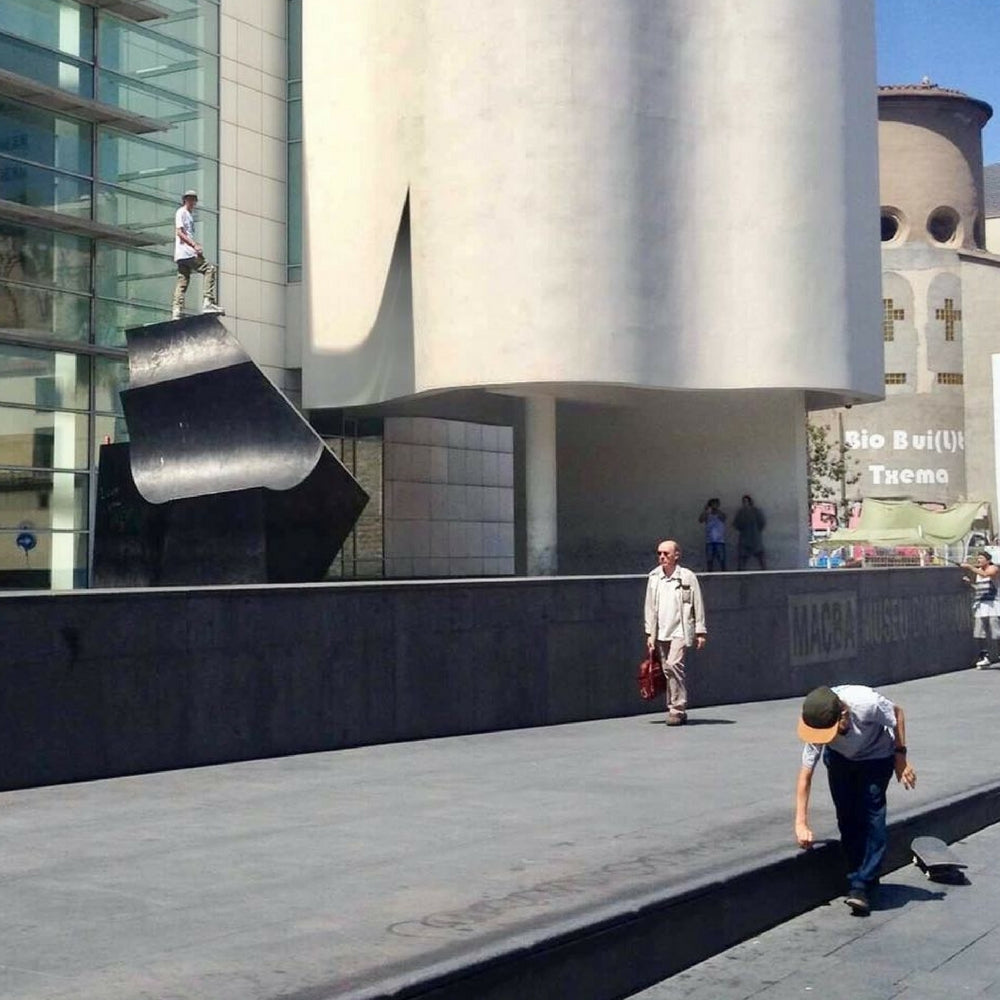The Art of Street Skating - by Chris Pullar

Skate Philosophy: The Art of Street Skating
Inline skating can be called numerous things; an activity, a sport, an art… Really? An art? Depends who you ask, I guess, but when you dig beneath the surface of why it is that we do what we do, beneath layers of determination, fear, anxiety, excitement, you may find an artist buried in there.
Football is not an art, generally speaking. It is a game, or a sport, with scoring, winners and losers, and rules. Skating has no rules. Sure, there may be some stigmas around ungrabbed fishbrain grinds or manoeuvres that are considered outdated or taboo in some circles (two-handed handstands on the coping of a ramp, for example; less common in 2017 as it was in 1995), but basically you can do what you want and no coach is going to call you out on not progressing. You win if you impress yourself, because you are the only person you’re up against. So unless you’re competing in a skate contest, skating is definitely not a sport. Now, the footballer who can do tricks with his ball, and chooses to adapt them to an environment other than the football field, that is when the footballer becomes less of a sportsman and more of an artist. When creativity for the sake of creativity comes in to play, the art is there for all to enjoy - if it’s on camera anyway. When there’s no camera around to capture the tricks, the art goes undocumented but nevertheless, the artistic flame is burning and the artist is expressing themselves through their tricks.
Take the humble street course; a skatepark that features types of obstacles designed to resemble those found in modern western metropolises around the world that lend themselves well to performing a variety of tricks on - tricks that were invented in the street environment on a curb or a handrail or a ledge of some description, though usually the ledges at the skatepark are far more user friendly than the ledges of the streets. You don’t have to adapt to the park, instead the park is a street scenario that has been adapted for skating. In contrast, skating in the street requires a deeper dedication.
So many factors come in to play in the street that some might consider such issues more than they’re interested in dealing with. Finding a good public ledge to skate, with a long and smooth run-up, plenty of smooth, flat space at the end of the ledge to land and roll away on, a good height that gives the skater just enough of a challenge to satisfy them without involving too much effort or risk, and a smooth edge to grind on, in a location that is free of people that might be concerned for the skater’s safety, legal liability risk, or the preservation of the obstacle itself which may or may not be at risk of damage from being skated… finding a ledge that ticks all these boxes can be like finding a unicorn - if you see one, take a picture and tell us where the rest of us can find it!

-Trent Phillips, back noogan to gap to fakie over the barrier into the driveway. Trent is a very driven man of lists and goals. You can see the rail he’s grinding is set about a foot and a half back from the wall is sits upon. This spot in Melbourne’s eastern suburbs has always been there, but nobody touched it until Trent came along.
Some would prefer to skate in the comfort of the street course at their local skatepark, or even venture to a skatepark further away that features that perfect obstacle that is of the perfect height, slides like butter and is an ideal angle that the skater can get a real buzz as they tackle the laws of physics, but not so much that they are too scared to try anything more than the basics. In contrast, skating in the street is usually far more challenging than the park. The imperfections of a street spot can challenge the skater physically, emotionally and mentally far more than the luxuries of the park. But furthermore, street skating calls on the skater’s imagination, requiring them to scout a location and adapt to an environment designed without skating in mind. And that’s when the inner artist comes out to play.

- Gav Drumm, backside shifty to cess slide down the wall to fakie. Gav is the skater’s skater, if you will. He would choose to do a trick you wish you’d thought of, and he’ll execute it in a fashion you could only dream of mimicking. Always thinking outside the box to a point where you think he may be biting off more than he should chew, don’t worry, Gav’s got this.
Many years ago there was a cheeky lad in Melbourne named Baz Travella in a crew that included the likes of my favourite “skater’s skater”, Gav Drumm and modern artistic street skating guru, Robbie Pitts. The comically clever Baz coined a term way back: potato skating. This referred to skating an obstacle that clearly lent itself to any number of tricks without much improvisation. A perfect downrail, for example, with its ideal length, lack of dangerous surroundings, lending itself to just about any trick, would be perfectly suited to a potato skater. The sort of skater that likes their tricks like they like their dinner: big, solid and straightforward but very satisfying. A meat and potatoes kind of person.Baz and his friends also had a term for the opposite end of the spectrum: tabouli skating. Tabouli is a middle eastern recipe made of tomatoes, parsley, mint, couscous and onion, a dish that required more creative flair from the chef to conjure up than the classic steak and mash. A tabouli skater would choose to skate the less obvious skate spot that requires them to think outside the box and tap deeper into their inner artist.
So you have the 360 topsoul on the massive perfect down-rail, versus say for example some obscure sculpture where the trick of choice is a fast plant to fakie-roll up a bank to walltap to topsoul stall on something to cess slide back down the bank. If you’re familiar with Robbie’s work you know which end of the spectrum he likes to roll. And if you’re not, let me tell you that when it comes to his art on the blades, his brush strokes are very refined.

- Robbie Pitts, cess slide down the stairs in downtown Melbourne. In the heart of a city is where Robbie enjoys street skating the most.

- Trent Phillips, true back savannah. The perfect down rail; good run up, and landing, even grass on one side to take the edge off your fears, should you find that you're not quite as fearless as Mr Phillips.
I’ve recently been making comparisons in my head between graffiti and street skating and drawing parallels. The graffiti artist refines their artwork in their sketchbook and brings it to a public space that will feature it well for all the world to see, carried at a discreet time of day or night, at a location that it is preferably not under constant surveillance of the authorities. The street skater refines their trick in the skatepark and takes it to a public spot that lends itself to the trick, also without immediately upsetting members of the public. He or she could easily achieve great things in the comfort of their sketchbook, or canvas, or skatepark, but they choose to take it a step further and adapt themselves to a space that was never constructed to host such artistry, all for the thrill and satisfaction of it, sometimes to be documented and appreciated by their peers, or sometimes simply for the enjoyment of the artist.
In the history of inline street skating, which is more than 20 years old but less than 30, there have been a number of significant changes. The people responsible for designing and constructing new public and private spaces that would previously have been ideal to skate, have now caught onto the destructive ways of blades, boarders and BMXers, and now metal strips and plates are installed across banks and ledges before the temporary fencing is removed, and to find a good new ledge without skate stoppers already installed in it is something people want to skate as a matter of urgency before it’s too late because often it’s just a matter of time before the builders come back and finish the job, rendering the spot un-skateable.

- Robbie Pitts, backslide. Robbie can skate anything, including spots many skaters wouldn’t notice. And not only will he hit that spot, he’ll session it. He is the improv master and puts emphasis on it looking and feeling right.
Another thing that’s changed is the number of skateparks in the community and an improvement in their construction and the variety of obstacles they feature. Now more than ever, one can ride a skatepark in ways the designers had never intended, if one has the right combination of ability and creativity. With less great street spots and more great parks, there has been a shift in where people choose to frequent on a Saturday in their skates. And in 2017, creativity seems to be more and more celebrated. Skating big burley spots for the sake of danger, that we saw lots of in the mid 2000’s, seems to have taken a back seat to a newer, more unorthodox approach to tricks.

- Gav Drumm, vertical soul stall on Chelsea mini ramp in Melbourne. Gav is constantly challenging an obstacle’s purpose, even in the skatepark. Not content with a perfect mini ramp in the conventional way, Gav will make the seemingly impossible not only possible, but stylish too.
Photo below - Chris in Spain at MACBA, aka the Barcelona Museum of Contemporary Art, a world famous street skating spot, rolling down a sculpture and immediately gapping over the wall, before security asked him to kindly not climb on the artwork.


